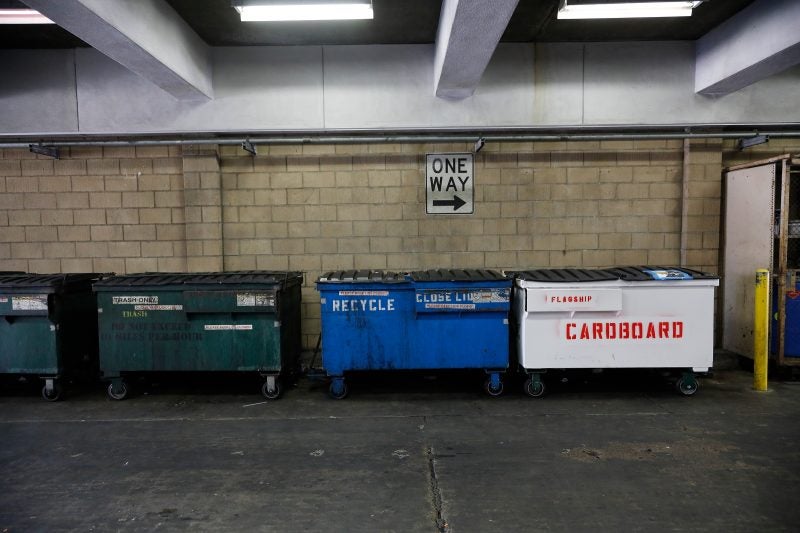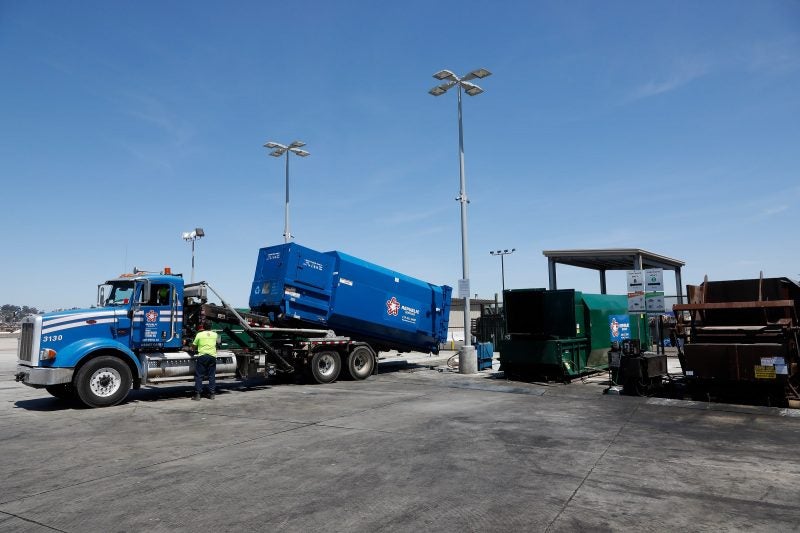
Every year since 2016, San Diego International Airport (SAN) has opened the doors of its Airport Innovation Lab to four companies and allowed them to field test ways to enhance the passenger experience, improve operational efficiency, decrease costs and increase revenue.
As part of this year’s 16-week programme, a selected batch of innovators has been invited to trial their solutions in an over-3,000ft2 terminal-like co-working space, where they can hold workshops, test prototypes and use ticket counters and bag claim carousels in real time.
This year’s group is largely focused on waste reduction. Of the four innovators, three are developing solutions that could optimise an airport’s waste management strategy and improve its sustainability credentials. As SAN itself highlights, this area is attracting increasing investment in the industry and already plays a key role in airports’ international profile.
The waste reduction strategies being tested at SAN

Trainable Carts used by Flagship Caption: Trainable carts used by Flagship. Credit: San Diego International Airport.
Having officially started in March, this year’s companies have only just been granted access to the lab due to the coronavirus pandemic. Before 30 June, which was the official kick-off date for the programme, they held virtual meetings and workshops with airport owner and operator the San Diego County Regional Airport Authority.
How well do you really know your competitors?
Access the most comprehensive Company Profiles on the market, powered by GlobalData. Save hours of research. Gain competitive edge.

Thank you!
Your download email will arrive shortly
Not ready to buy yet? Download a free sample
We are confident about the unique quality of our Company Profiles. However, we want you to make the most beneficial decision for your business, so we offer a free sample that you can download by submitting the below form
By GlobalDataZeroWaste’s flagship smart waste unit uses AI-driven robotics and auto-sorting technology to process waste, grind it into small pellets and package the raw sorted material. The solution is estimated to capture 30%-40% more recycled materials than traditional systems and can lead to cost reductions of between 40% and 50%.
Seattle-based Encora has developed reusable food and drink containers that rely on software and quick response/radio-frequency identification chips to guide users to the nearest designated smart collection station for on-site cleaning. These containers can be reused up to 1,000 times and then recycled to contribute to the circular economy.
Thirdly, Keko Inc has developed reusable food containers and dishware, as well as a contact-free pick-up system designed for the post-Covid-19 age.
The fourth company, SkyLights, is developing airport entertainment solutions based on virtual reality. At the end of the programme, the innovators are hoping to win a contract from the San Diego County Regional Airport Authority or increase their profile within the wider transport industry.
Beyond the Innovation Lab: how does SAN process waste?

Cardboard Bales to be Recycled. Credit: San Diego International Airport.
Outside the Innovation Lab is a much wider and diversified airport ecosystem that produces some 8,600 tonnes of waste every year, according to San Diego County Regional Airport Authority senior communications specialist Nicole Hall.
Over the last three years, the operator has put a number of measures in place to increase the amount of waste being recycled. In 2018, this figure amounted to 1,645 tonnes out of a total 8,600 tonnes, though it increased to 1,888 tonnes the following year. As of late, figures provided by Hall show a reduction of 53% in landfill waste between January and June this year compared to the same time last year. In addition, 40% fewer materials have been recycled in a commingled way.
Within this framework, a key pillar in SAN’s waste reduction strategy is employee training. This includes sharing updated information on the topic and mandating training modules for all workers to undergo. “This ensures that all employees receive annual training and are properly educated on the current state of the authority’s recycling programmes,” comments Hall.
“There is also a sustainability presentation for the authority’s new hire employees that highlights environmental initiatives at the airport and how employees can contribute to sustainability goals. Especially highlighted is waste reduction and diversion, as well as proper composting practices.”
While the four innovators were forced to shift to a virtual format by the Covid-19 pandemic, it has had little impact on the airport’s overall waste management system. If anything, reduced operations have helped decrease the amount of waste generated throughout the airport.
“The only challenge we’ve experienced is the stopping of cabin service in the aircraft, so any waste that is collected during the flight is sent to the landfill,” Hall says. “So the airlines have stopped recycling at this time, but they are producing little waste considering many carriers still don’t have any cabin service at the moment.”
Future strategies

The central recycling and waste disposal facility at SAN. Credit: San Diego International Airport.
As it waits for passenger traffic to resume to normal levels, the San Diego County Regional Airport Authority is also preparing to implement new waste reduction strategies across its venues.
“The Zero Waste Plan provides an organised framework for eliminating or reducing waste generation and responsibly managing materials that we do produce,” explains Hall. “[SAN] sees zero waste as addressing five primary focus areas, including sustainable materials management, infrastructure and development, training and education, metrics and reporting, and leadership and influence.”
The plan was recently picked up by the US Environmental Protection Agency as a case study as it aims to reduce discarded material per passenger by 10% and achieve a 90% diversion rate, as well as third-party certification of zero waste by 2035.
Among the waste prevention strategies included in the plan are adopting reusable dishes, coffee mugs and flatware and the planting of drought-tolerant California-native plants that use less water and produce less green waste. On the diversion and recycling front are initiatives such as the Innovation Lab, recycling bins and liquid collection units, and an expanded recycling programme that includes plastic shrink wrap, used electronics, larger metal pieces, and construction and demolition debris.
The operator is also currently finalising its Airport Development Plan (ADP) and five-year rolling Capital Improvement Program (CIP), both of which will lead to new reduction measures.
“While the ADP recommends improvements, including sustainable design upgrades related to facilities that will allow the authority to improve environmental performance, the CIP identifies specific upcoming projects that are planned for construction, several of which will directly influence waste management strategies,” Hall concludes.




